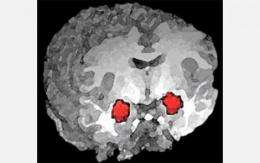Scientists discover anti-anxiety circuit in brain region considered the seat of fear

Stimulation of a distinct brain circuit that lies within a brain structure typically associated with fearfulness produces the opposite effect: Its activity, instead of triggering or increasing anxiety, counters it.
That's the finding in a paper by Stanford University School of Medicine researchers to be published online March 9 in Nature. In the study, Karl Deisseroth, MD, PhD, and his colleagues employed a mouse model to show that stimulating activity exclusively in this circuit enhances animals' willingness to take risks, while inhibiting its activity renders them more risk-averse. This discovery could lead to new treatments for anxiety disorders, said Deisseroth, an associate professor of bioengineering and of psychiatry and behavioral science.
The investigators were able to pinpoint this particular circuit only by working with a state-of-the-art technology called optogenetics, pioneered by Deisseroth at Stanford, which allows brain scientists to tease apart the complex circuits that compose the brain so these can be studied one by one.
"Anxiety is a poorly understood but common psychiatric disease," said Deisseroth, who is also a practicing psychiatrist. More than one in four people, in the course of their lives, experience bouts of anxiety symptoms sufficiently enduring and intense to be classified as a full-blown psychiatric disorder. In addition, anxiety is a significant contributing factor in other major psychiatric disorders from depression to alcohol dependence, Deisseroth said.
Most current anti-anxiety medications work by suppressing activity in the brain circuitry that generates anxiety or increases anxiety levels. Many of these drugs are not very effective, and those that are have significant side effects such as addiction or respiratory suppression, Deisseroth said. "The discovery of a novel circuit whose action is to reduce anxiety, rather than increase it, could point to an entire strategy of anti-anxiety treatment," he added.
Ironically, the anti-anxiety circuit is nestled within a brain structure, the amygdala, long known to be associated with fear. Generally, stimulating nervous activity in the amygdala is best known to heighten anxiety. So the anti-anxiety circuit probably would have been difficult if not impossible to locate had it not been for optogenetics, a new technology in which nerve cells in living animals are rendered photosensitive so that action in these cells can be turned on or off by different wavelengths of light. The technique allows researchers to selectively photosensitize particular sets of nerve cells. Moreover, by delivering pulses of light via optical fibers to specific brain areas, scientists can target not only particular nerve-cell types but also particular cell-to-cell connections or nervous pathways leading from one brain region to another. The fiber-optic hookup is both flexible and pain-free, so experimental animals' actual behavior as well as their brain activity can be monitored.
In contrast, older research approaches involve probing brain areas with electrodes to stimulate nerve cell firing. But an electrode stimulates not only all the nerve cells that happen to be in the neighborhood but even fibers that are just passing through on the way to somewhere else. Thus, any effect from stimulating the newly discovered anti-anxiety circuit would have been swamped by the anxiety-increasing effects of the dominant surrounding circuitry.
In December 2010, the journal Nature Methods bestowed its "Method of the Year" title on optogenetics.
In the new Nature study, the researchers photosensitized a set of fibers projecting from cells in one nervous "switchboard" to another one within the amygdala. By carefully positioning their light-delivery system, they were able to selectively target this projection, so that it alone was activated when light was pulsed into the mice's brains. Doing so led instantaneously to dramatic changes in the animals' behavior.
"The mice suddenly became much more comfortable in situations they would ordinarily perceive as dangerous and, therefore, be quite anxious in," said Deisseroth. For example, rodents ordinarily try to avoid wide-open spaces such as fields, because such places leave them exposed to predators. But in a standard setup simulating both open and covered areas, the mice's willingness to explore the open areas increased profoundly as soon as light was pulsed into the novel brain circuit. Pulsing that same circuit with a different, inhibitory frequency of light produced the opposite result: the mice instantly became more anxious. "They just hunkered down" in the relatively secluded areas of the test scenario, Deisseroth said.
Standard laboratory gauges of electrical activity in specific areas of the mice's amygdalas confirmed that the novel circuit's activation tracked the animals' increased risk-taking propensity.
Deisseroth said he believes his team's findings in mice will apply to humans as well. "We know that the amygdala is structured similarly in mice and humans," he said. And just over a year ago a Stanford team led by Deisseroth's associate, Amit Etkin, MD, PhD, assistant professor of psychiatry and behavioral science, used functional imaging techniques to show that human beings suffering from generalized anxiety disorder had altered connectivity in the same brain regions within the amygdala that Deisseroth's group has implicated optogenetically in mice.













